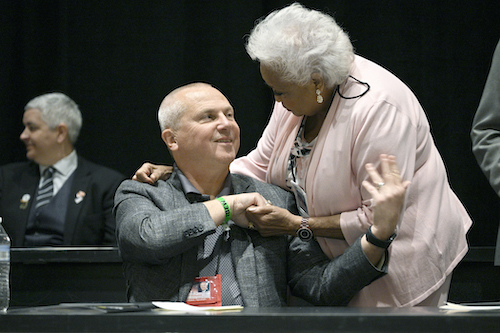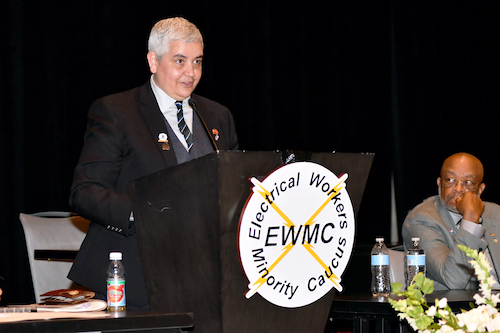On Saturday morning, hundreds of convention delegates gathered in the leadup the IBEW’s 40th International Convention to support one another and a shared vision for a more diverse and equitable IBEW through the Electrical Workers Minority Caucus.

|
| IBEW International President Lonnie R. Stephenson shares a personal moment with Electrical Workers Minority Caucus President Emeritus Robbie Sparks before Sparks’s address to the EWMC meeting on Saturday, May 7.
|

|
|
Ticha Albino, a member of the Electrical Workers Minority Caucus’s executive board and the human rights business representative for Toronto, Ontario, Local 353, makes a presentation as a Diversity, Equity and Inclusion panelist during the Saturday, May 7, EWMC meeting.
|
Building on the convention’s slogan, “Lighting the Path to the Middle Class,” the theme for Saturday’s EWMC gathering, “Bridge to the Middle Class: Leading the Way Through Diversity, Equity and Inclusion,” took its cue from the more than three dozen Chicago River bridges that crucially connect the people and businesses of that waterway’s namesake city.
In her opening remarks, EWMC Vice President Grace Smith said that “diversity, equity and inclusion are not just buzz words. They’re how we build a better union.
“Unions have long struggled with inclusion,” said Smith, a member of Tampa, Fla., Local 824. But because of the work of the EWMC, “the IBEW has a natural life link to grow the organization,” she said.
The EWMC was established in 1974, after a group of primarily Black members threatened to form an informational picket at the union’s 30th International Convention in Kansas City, Mo., over the underrepresentation of minorities in the union and on staff at the International Office. At that convention, fewer than 100 of the 3,000 delegates were Black, as were just one international representative and one international office staffer in Washington, D.C. After a meeting was arranged between the protestors and then-International President Charles Pillard, the caucus was formally established by that convention.
One of those protestors on the ground in Kansas City in 1974 had been Mary O’Brien, a trailblazing activist who went on to become the first Black woman to serve as an international representative. O’Brien’s recent death on March 19 was sadly noted by Seattle Local 46 Business Manager and EWMC executive board member Sean Bagsby during the caucus’s “in memoriam” segment. (Read more about O’Brien in the May 2022 edition of the Electrical Worker.)
Another protestor at the 1974 convention was EWMC President Emeritus Robbie Sparks, a retired Atlanta Local 2127 business manager.
“We decided we were unhappy with the way things were,” Sparks recalled for those at the caucus gathering. “But we knew the best was yet to come.”
“Back in the day, we were exclusive, not inclusive,” admitted Chicago Local 134 Business Manager Don Finn. “But change is coming. When we go out to the jobsite, we see the union of the future.”
Sparks spoke about the future as well. “It’s so important that we recognize what we’re up against,” she said. “Ask yourselves: ‘What are you doing to organize?’ We need to go organize and tell our story.”
“Organizing is difficult enough without adding barriers,” noted EWMC President Keith Edwards, who is both a retired Ninth District international representative and the first Black business manager of a construction local: Portland, Ore., Local 48. As it is in every labor organization, “organizing is Job One,” Edwards said. “Retention is Job Two.”
And when workers from all backgrounds can see their reflections in IBEW faces, said International President Lonnie R. Stephenson, it makes us stronger.
“Dignity, respect and a voice on the job are what we’re all about,” Stephenson said. “I don’t think most of us intend to discriminate, but we all have biases. We need to keep that in mind when we’re meeting new people. It’s not easy; it takes a lot of work.”
That’s why diversity, equity and inclusion are now a top priority of the IBEW, he said, “making sure our doors are wide open to anyone who wants to work in the electrical industry.”
DEI is central to the goals of the union’s IBEW Strong initiative, which Stephenson described as “vital to building the IBEW.”
Senior Executive Assistant to the International President Sherilyn Wright, along with Director of Civic and Community Engagement Tarn Goelling and Education Department Director Amanda Pacheco, went into greater detail about IBEW Strong, which was called for by the 39th International Convention in St. Louis “to grow and strengthen the IBEW through inclusion,” Wright said.
Soon after that convention, International President Stephenson selected a 35-member IBEW Strong committee from locals across North America. The committee quickly engaged the services of Dushaw Hockett, a nationally recognized leader in training, community building and organizational development, for guidance and advice.
IBEW Strong’s guiding principles, Wright said, are organizing, education and training, membership activism, leadership advances and replicating best practices. The program is set to be launched across North America in the coming weeks.
But IBEW Strong would not be the program it has become without the EWMC, said International Secretary-Treasurer Kenneth Cooper. “EWMC is such a crucial organization to the IBEW and to the future of the union movement,” he said. “It’s exactly what we need to achieve what we want for the future.”
Cooper asked the attendees to stand up and look at each other. “Every union hall in the IBEW can look like this room,” Cooper said. “But it’s up to you. Each of you has that power. The country needs every one of us because so much is at stake. It’s about who will fight for out rights and our benefits.”
“The IBEW does look like this room,” said International Executive Committee Chairman Chris Erikson, business manager of New York Local 3. “The labor movement got us to where we are, and the EWMC continues to move this organization forward.”
Sixth District International Vice President Paul Noble thanked the EWMC for what it does. “To have real impactful change is difficult, hard work,” Noble said.
In introducing the chapter presidents’ reports, EWMC Executive Board member Joseph Wells noted that the organization has grown to 42 chapters across the U.S. and Canada. “We’ve gotten the message out,” said Wells, a member of Chicago Local 134.
Representatives of nearly a dozen of those EWMC chapters delivered reports covering many of their activities since the last convention, which ran from food banks to rewiring projects, toy and coat drives to mentorships, plus parades and participation in Juneteenth events. A lot of these events required innovative thinking because of the COVID-19 pandemic.
Goelling then moderated a panel on diversity, equity and inclusion, where each panelist shared personal stories about how the EWMC can help members deal with issues such as retention, mentorship and on-the-job training.
“Being diverse is not just saying you are, but showing it,” said panelist Stephen Gonzales, an EWMC executive board member and assistant business manager of Denver Local 111.
A fellow panelist, St. Louis Local 1 Secretary and DE&I Director Sylvester Taylor, agreed. “You have to be engaged and active,” said Taylor, president of Local 1’s EWMC Chapter. “The only thing on the other side of this is work.”
The other panelists were EWMC Executive Board member Ticha Albino from Toronto, Ontario, Local 353; Alvin Dayoan from Vacaville, Calif., Local 1245; EWMC RENEW Executive Board member Edward Nieves from New York Local 3; Local 613 EWMC Chapter President Gabrielle Saylor; and Felicia Wiseman, EWMC Executive Board member and Detroit Local 58 treasurer and organizer.